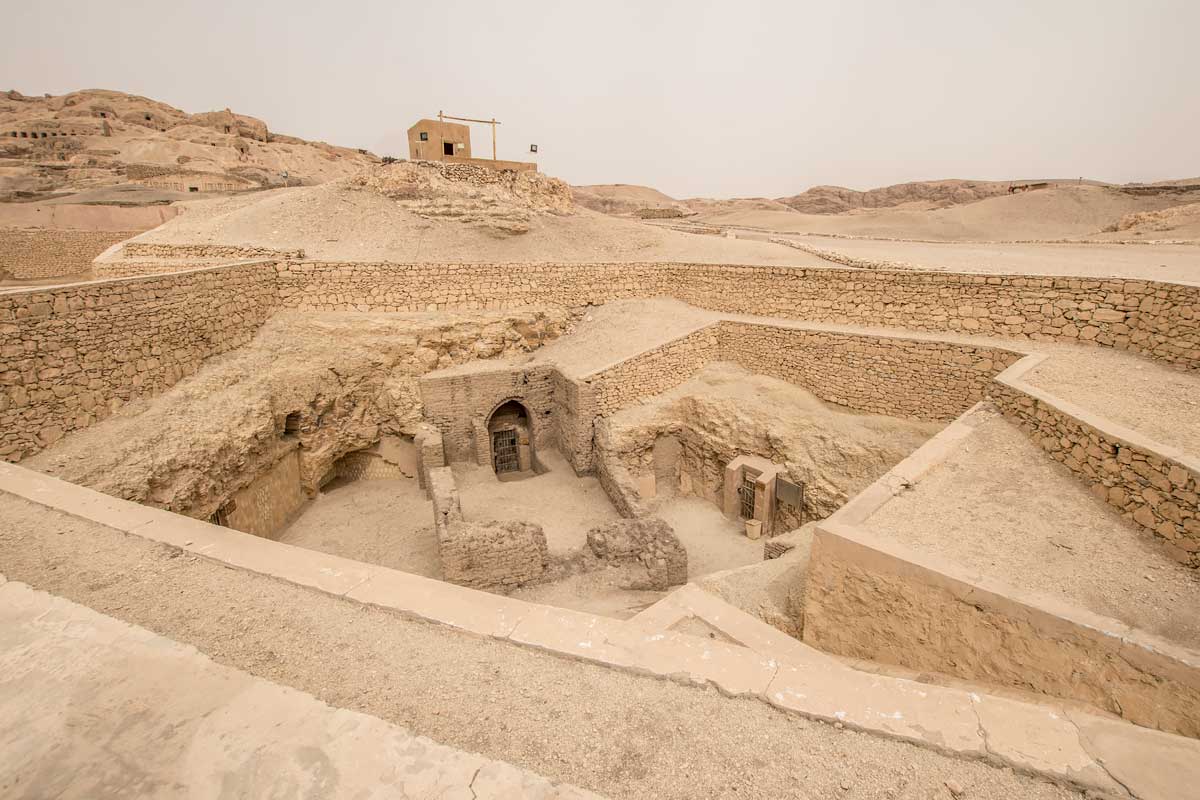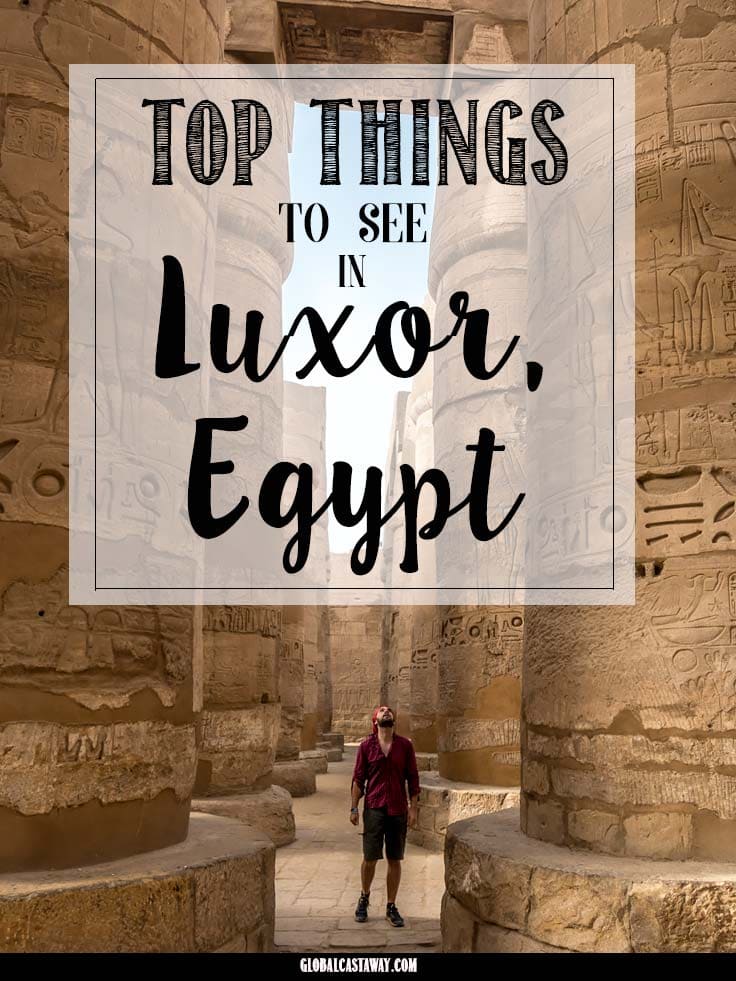While the pyramids are the first thing that comes to mind when people think of Egypt, 500km south of there, is the real gem of the ancient world. By visiting Luxor, Egypt (a few thousand years older than Luxor, Vegas) you will transport yourself back to a time of gods and pharaohs, temples and tombs, myths, and golden treasures.
What to see in Luxor, Egypt
Luxor is divided by the Nile to an East and a West Bank. Both of them – with substantial meaning for the ancient Egyptian people. The most significant god back then was Amun, and like a lot of other major gods – he was the god of the sun.
So quite naturally, the east bank (where the sun rises) was the place for the living. The central city is there, and the two temples on this side of the river are built to celebrate life and the sun.
East Bank
Karnak temple

The Karnak Temple complex construction started 4000 years ago and continued until the Romans conquered Egypt – 2000 years ago. Yep, you read that right; this place was built over 2000 years! Every ruler of Egypt left its mark on it, and even Napoleon soldiers left behind some graffiti of their own.
Nowadays, the temple rivals The Pyramids as the emblem of Egypt, and it’s already the most instagramable place in the country. When you visit Karnak, find the giant Scarab statue. Circle around it seven times, counter-clockwise, and make a wish. Now you have the ancient Egyptian gods on your side.
Price: 220 EGP /7 USD, tickets bought at sight.
Tip: Get there first thing in the morning. Most tours start from the Valley of the Kings, so getting up early to Karnak guarantees you this stunning place, free of crowds.
Opens at: 6:00 AM but double-check it with your hotel.
See Also: Cairo – The Good, The Bad and the Ugly
Luxor Temple

The other temple in the city is the Luxor temple. It’s connected to the other temple by a sphinx guarded road, but unlike Karnak, it took only 500 years to be built.
Some gigantic statues of Ramses II and Tutankhamon plus some pretty…hmm…interesting wall decorations await you there, making the Luxor temple a must-see. It’s also right in the center of the city, so it’s quite effortless to get to.

Price: 180 EGP / 6 USD
Tip: Get there right after you visit Karnak and explore it in peace.
Opens at: 6:00 AM but double-check with your hotel.
And if the east bank is for the living, the west one should be for? That’s right – the dead. Also known as “City of the Dead” on the west bank you can see various tombs and mortuary temples that celebrate death and the afterlife.
West Bank
The Valley of the Kings

This place alone should be the main reason for visiting Luxor, Egypt. The Valley of the Kings is the most prominent highlight of the city, and it has been like that for the last 100 years, ever since Howard Carter discovered the nearly intact tomb of the pharaoh Tutankhamun.
The blinding white-rock valley was used by the pharaohs of the new Egyptian kingdom, as a burial place for royals, high priests, and other elite. It is the most preserved piece of ancient history I’ve seen, blowing out of the water places like the Roman Colosseum or the Acropolis of Athens.
Walking around the burial chambers, you’ll surely forget the age of the place. Even though it’s 4000 years old, the decorations look not a year older than 40. Seriously, I’ve seen houses that look more ancient than these tombs!
This place is such an underrated bucket list experience that planning a trip to Egypt, for the sole reason of seeing it, won’t be unreasonable at all (I’m planning a second one just so I can check out more tombs).
Prices:
General Entry ticket – 260 EGP /8.50 USD (includes three tombs of your choice.)
Photo pass -300 EGP /10 USD
Additional tickets for:
Rameses 5th & Rameses 6th: 120 EGP /4 USD
Tutankhamun: 300 EGP / 10 USD
Seti 1st: 1000 EGP / 32 USD
Tip: Most of the tours in Luxor starts with The Valley of the Kings. Go there in the afternoon (around 3:00 PM) and enjoy it without the massive crowds.
Mortuary Temple of Hatshepsut

Hatshepsut was the second known woman pharaoh. Not only that but she was also one of the most successful ones, creating various trade routes and leading the kingdom to prosperity. Her mortuary temple style is a little bit different from the other Egyptian temples, and it’s considered to be the closest Egypt came to Classical architecture.
The most curious thing is that all but one (apparently it was forgotten) Hatshepsut images are torn down and erased from the wall decoration of the temple. There are a few theories about who and why did it, as the most popular one is that her son was responsible for the deed.
At the end of his life, he decided to put her where all women in power were supposed to be – a regent, not a pharaoh. This almost made her disappear from the history books and created a lot of headaches for the Egyptologists.
Price: 160 EGP / 5 USD, bought at the sight
Habu Temple

When visiting Luxor, Egypt, make sure you include Habu Temple in your itinerary. Also known as the Mortuary Temple of Ramesses III, is probably the most underrated sight at Luxor. Not a lot of tours going there and a little information online can give you the impression there is nothing special about the place while the temple is as impressive ( if not even more) as the Karnak and Luxor temples. 150 meters long, it contains more than 7,000 m2 (75,347 sq ft) of decorated wall reliefs and some remarkable columns where you can get the perfect Instagram picture.
Price: 100 EGP / 3 USD – bought from the ticket office next to North El Gourna Hotel and the Colossi of Memnon (exact coordinates – 25.722725, 32.604387)
See Also: Red Sea – Facts & Photos
Deir el-Medina + Nobels’ Tombs

Hundreds of years of rock carving need some serious workforce. Deir el-Medina is the place where all the workers that excavated the Valley of the Kings used to live. Since they weren’t slaves, they were promised a glorious afterlife in exchange for their services. And since they had the skills to paint and decorate a king’s tomb, they decided to decorate their own too.
Close to Deir el-Medina are the nobles’ tombs. Ancient priests and celebrities wanted to be right next to the pharaohs in the afterlife and had the resources to afford it. I visited the tombs of Menna and Nakht, and they were quite the sight.
Deir el-Medina price: 100 EGP / 3 USD
Menna and Nakht price: 60 EGP / 2 USD
Tickets sold at the ticket office next to North El Gourna Hotel and the Colossi of Memnon (exact coordinates – 25.722725, 32.604387).
Castaway Tip
Visit the worker’s and the nobles’ tombs before you visit the Valley of the Kings. It’s quite curious to make the comparison between the different classes in ancient Egypt but as bright and shiny colored as they are, the tombs of the pharaohs are way above them.
Other things to do while visiting Luxor, Egypt

Luxor is a tourist city, so there are a lot of things to do in it. The nightlife is buzzy, and the shisha bars are everywhere. There is also a big market street where you can catch up on souvenirs, herbs, and jewelry.
Some of the most popular attractions are balloon riding on sunrise or Nile cruising to Aswan or Cairo. If you decide to go balloon riding make sure to do it with a reputable company. There was a recent case of a crashed balloon that killed one tourist and injured a dozen.
There are also two museums inside the city – The Mummification Museum (100 EGP) and the Luxor Museum (140 EGP). If your time is limited, I suggest the Luxor Museum. It’s not a large one; an hour is enough to check it out, it’s way more organized than the one in Cairo, there are a few mummies inside and you can even take a picture of them if you get a photo pass.
How to get to Luxor?

By plane: Even though it’s not a huge city, there is an international airport near the city. There are also daily flights from Cairo and even some options from Hurghada
By train: If you don’t fancy flying you can get the sleeper train from Cairo.
By bus: It’s a long ride, but if you get the night-bus you can save yourself some time and money.
By boat: If you have time to spare, you can go and explore Aswan first and take a boat cruise on the Nile to Luxor. Not the most efficient way of travel but certainly the most spectacular.
Where to stay in Luxor
Luxury

The 5-star hotel offers all of the luxuries you expect from a Hilton hotel with the unique touch of Egypt. Enjoy the infinity pool next to the Nile or go for a run overlooking the mighty river inside the state of the art gym.
See the latest prices
Mid Range

Another 5-star hotel, however, the price is nowhere near the Hilton one. Pavillon Winter Luxor offers 3 restaurants, 2 bars, a spacious garden, and warm hospitality right in the heart of city.
See the latest prices
Budget

This is the one I used on my trip to Luxor. Overlooking Luxor temple, the hotel has the perfect location and even has breakfast included in the price. Not the most spacious rooms but definitely a great value.
See the latest prices
Luxor Tours

While visiting Luxor, Egypt, you’ll find out that the highlights are well spread around the city, and the best way to see them is to book a guided tour with a driver. You’ll get some knowledge from a professional Egyptologist and won’t waste time searching for the right way to the next sight.
Finding a good guide in Egypt could be a tricky thing though. For the whole trip, I got only one I enjoyed, and thankfully it was in Luxor. Her name is Rania, and if you shoot her a mail at rania_rawan@hotmail.com, she’ll be more than happy to organize your Luxor adventure.
However, if you prefer booking through an agency here are the best tour options.
That’s all from me, I hope I convinced you that visiting Luxor, Egypt is a bucket list must-have!
————————————
If you haven’t planned your trip there yet, find out how I plan my trips!
————————————
I’ve got 9 bucket list ideas for Egypt. See my impossible bucket list of 1700+ adventures!
Do you have something I should add to the list?

Some of the above are affiliate links and I will earn a percentage of the sale if you purchase through them at no extra cost to you. This helps keep my site running – so thanks in advance for your support!




Wednesday 11th of September 2019
5